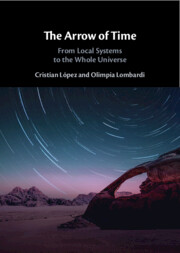Book contents
- The Arrow of Time
- The Arrow of Time
- Copyright page
- Contents
- Contributors
- Preface
- Acknowledgments
- Part I Local Systems
- Part II The Arrow of Time and Philosophical Issues
- Part III The Arrow of Time and Time-Reversal Invariance
- Part IV The Whole Universe
- 11 Following Earman’s Time Direction Heresy: From the Global Arrow of Time to Local Irreversible Processes
- 12 The Seeds of Cosmic Structure, the Black Hole Information Puzzle, and the Entropic Arrow of Time
- 13 Finding Time for Wheeler–DeWitt Cosmology
- Index
- References
12 - The Seeds of Cosmic Structure, the Black Hole Information Puzzle, and the Entropic Arrow of Time
from Part IV - The Whole Universe
Published online by Cambridge University Press: 28 October 2025
- The Arrow of Time
- The Arrow of Time
- Copyright page
- Contents
- Contributors
- Preface
- Acknowledgments
- Part I Local Systems
- Part II The Arrow of Time and Philosophical Issues
- Part III The Arrow of Time and Time-Reversal Invariance
- Part IV The Whole Universe
- 11 Following Earman’s Time Direction Heresy: From the Global Arrow of Time to Local Irreversible Processes
- 12 The Seeds of Cosmic Structure, the Black Hole Information Puzzle, and the Entropic Arrow of Time
- 13 Finding Time for Wheeler–DeWitt Cosmology
- Index
- References
Summary
The conceptual problems of quantum theory make a particularly strong appearance in contexts such as black hole physics, or the physics of the very early universe, where the theory must be used with nothing that could be reasonably given the “role of observer” or a “measuring device.” As such, those situations offer a rather fertile ground, where proposals for dealing with those problems could produce results that actually differ substantially from the ones obtained within the “standard type” of studies, where those questions are essentially ignored. We will explore the ways in which one of the proposals to address the so-called measurement problem affects various specific issues that arise within the above-mentioned fields. We will see that in our specific approach to the subject several well-known and concrete problems seem to simply disappear, and in particular, that it could offer a novel and unexpected account for the nature of the entropic arrow of time in cosmology.
Information
- Type
- Chapter
- Information
- The Arrow of TimeFrom Local Systems to the Whole Universe, pp. 250 - 266Publisher: Cambridge University PressPrint publication year: 2025
References
Accessibility standard: WCAG 2.1 AA
Why this information is here
This section outlines the accessibility features of this content - including support for screen readers, full keyboard navigation and high-contrast display options. This may not be relevant for you.Accessibility Information
Content Navigation
Allows you to navigate directly to chapters, sections, or non‐text items through a linked table of contents, reducing the need for extensive scrolling.
Provides an interactive index, letting you go straight to where a term or subject appears in the text without manual searching.
Reading Order & Textual Equivalents
You will encounter all content (including footnotes, captions, etc.) in a clear, sequential flow, making it easier to follow with assistive tools like screen readers.
You get concise descriptions (for images, charts, or media clips), ensuring you do not miss crucial information when visual or audio elements are not accessible.
Visual Accessibility
You will still understand key ideas or prompts without relying solely on colour, which is especially helpful if you have colour vision deficiencies.
Structural and Technical Features
You gain clarity from ARIA (Accessible Rich Internet Applications) roles and attributes, as they help assistive technologies interpret how each part of the content functions.
